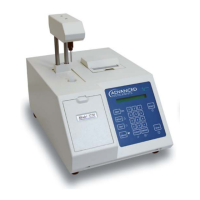16
2
Calibration
The 3250 has two ranges, each with its own calibration.
• To calibrate the low range, three freezing-point tests are required at the 0 mOsm/Kg H₂O
(if enabled) and 100 mOsm/kg levels, and six tests are required at the 1500 mOsm/kg
level.
• To calibrate the high range, six freezing-point tests are required at both the 1500 mOsm/
kg level and the 3000 mOsm/kg level.
The 4250 allows timed or plateau-seeking calibration in either the Hortvet (m°H) or
the Celsius (m°C) scale. Six freezing-point tests are required at each of the 4250’s two
calibration levels:
• -408 m°C (-422 m°H)
• -600 m°C (-621 m°H)
Note If you see the message Recalibration Needed, follow the instrument prompts to
complete the initial calibration. Your calibration may vary slightly from that mentioned
here.
Refer to the Model 3250 or Model 4250 user's guide for additional information on calibration.
Calibrate the instrument according to the instructions below:
1. Turn the instrument on.
2. If there is a Supervisor/Operator keyswitch, turn it to the Supervisor position. It must
remain there throughout calibration.
3. To enable the optional Zero Calibration:
a. Press SETUP
b. Press < or > to cycle to the Zero calibration option
c. Press START.
d. Press ENTER at the On option.
4. Press CALIB to begin the calibration sequence.
5. The display will prompt you at each calibration level. Place a sample of the first
calibration standard into the freezing chamber and press START.
6. Continue loading and testing samples at the first calibration level until the display
prompts you for samples at the second calibration level.
7. Place the sample of the second calibration standard into the freezing chamber and press
START.
8. When the instrument has completed calibration, the display will read Calibration
Complete.

